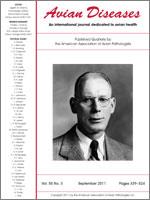Actions concerning animal health in turkey production are coming more and more to the fore. Litter quality has a great impact on the bird's health and welfare. This study aimed at evaluating the effects of using floor heating, different litter materials, and exposure to litter with a “critical moisture content” of 35% for 16 or 24 hr/day on the severity of foot pad dermatitis (FPD), a widespread disease in fattening turkeys. Four groups of 2-wk-old female turkeys, with 20 birds in each, were reared during 3 wk. All turkeys were fed a commercial pellet diet ad libitum. The first two groups were kept on wood shavings (35% moisture) without and with floor heating. The other two groups were housed on lignocellulose (Soft Cell®) of 35% moisture without and with floor heating. In each group, half of the birds were housed for 8 hr/day in adjacent separate boxes where the litter was kept clean and dry throughout the experimental period. Foot pads were assessed weekly for external and at day 35 for histopathologic scoring (scores: 0 = healthy; 7 = ulcer). At day 14 each bird had normal and healthy foot pads. The results indicate that using floor heating resulted in significantly lower FPD scores (0.8 ± 0.2) compared to groups without floor heating (2.0 ± 0.8). Using lignocellulose as a litter material resulted in significantly lower histopathologic FPD scores (1.4 ± 0.7) compared with wood shavings (1.7 ± 0.8). In all birds housed on dry litter for 8 hr/day, significantly lower FPD scores were found compared to birds housed on wet litter for 24 hr. In conclusion, using floor heating, even with wet litter (35% moisture), independent of the litter type, resulted in reduced severity of FPD compared to those birds housed in pens without using floor heating. Additionally, using lignocellulose as a litter material resulted in lower FPD compared with wood shavings. Keeping litter dry and “warm” could be achieved by using floor heating, which is considered a practical step to enhance animal health and welfare.
BioOne.org will be down briefly for maintenance on 17 December 2024 between 18:00-22:00 Pacific Time US. We apologize for any inconvenience.
How to translate text using browser tools
1 September 2011
Effects of Floor Heating and Litter Quality on the Development and Severity of Foot Pad Dermatitis in Young Turkeys
A. Abd El-Wahab,
A. Beineke,
M. Beyerbach,
C. F. Visscher,
J. Kamphues
ACCESS THE FULL ARTICLE

Avian Diseases
Vol. 55 • No. 3
September 2011
Vol. 55 • No. 3
September 2011
floor heating
foot pad dermatitis
litter type
young turkeys




